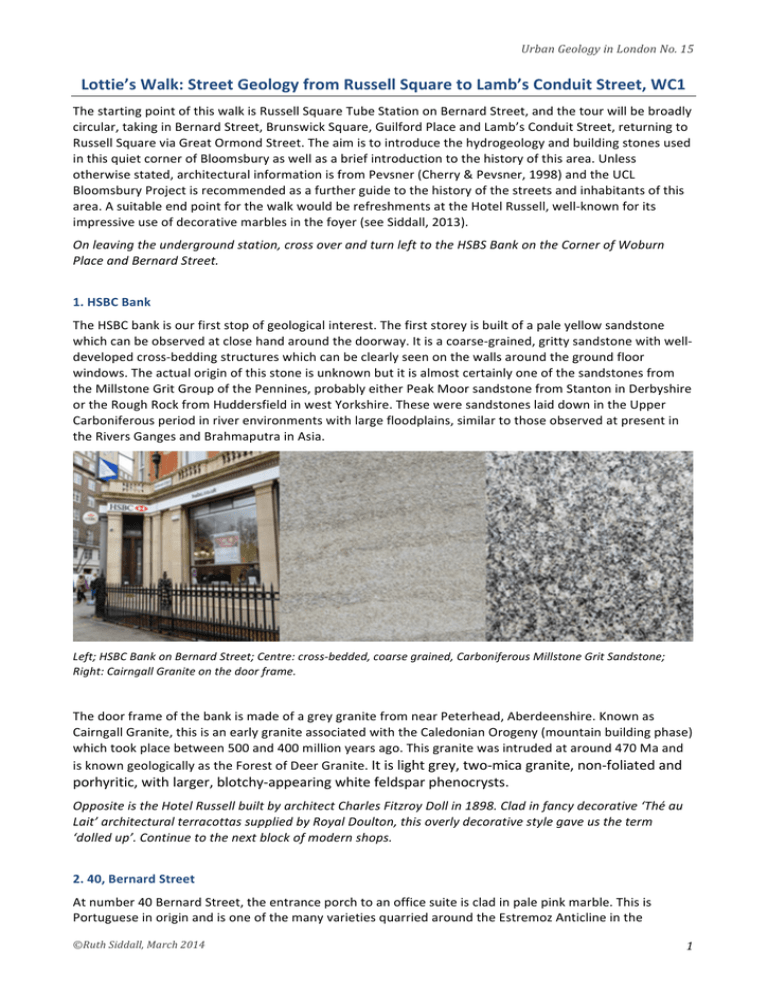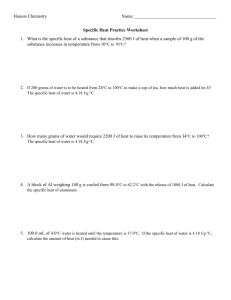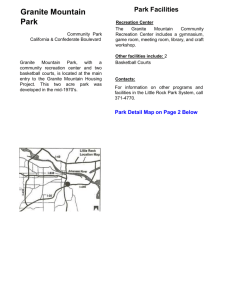Document 12425223
advertisement

Urban Geology in London No. 15 Lottie’s Walk: Street Geology from Russell Square to Lamb’s Conduit Street, WC1 The starting point of this walk is Russell Square Tube Station on Bernard Street, and the tour will be broadly circular, taking in Bernard Street, Brunswick Square, Guilford Place and Lamb’s Conduit Street, returning to Russell Square via Great Ormond Street. The aim is to introduce the hydrogeology and building stones used in this quiet corner of Bloomsbury as well as a brief introduction to the history of this area. Unless otherwise stated, architectural information is from Pevsner (Cherry & Pevsner, 1998) and the UCL Bloomsbury Project is recommended as a further guide to the history of the streets and inhabitants of this area. A suitable end point for the walk would be refreshments at the Hotel Russell, well-­‐known for its impressive use of decorative marbles in the foyer (see Siddall, 2013). On leaving the underground station, cross over and turn left to the HSBS Bank on the Corner of Woburn Place and Bernard Street. 1. HSBC Bank The HSBC bank is our first stop of geological interest. The first storey is built of a pale yellow sandstone which can be observed at close hand around the doorway. It is a coarse-­‐grained, gritty sandstone with well-­‐ developed cross-­‐bedding structures which can be clearly seen on the walls around the ground floor windows. The actual origin of this stone is unknown but it is almost certainly one of the sandstones from the Millstone Grit Group of the Pennines, probably either Peak Moor sandstone from Stanton in Derbyshire or the Rough Rock from Huddersfield in west Yorkshire. These were sandstones laid down in the Upper Carboniferous period in river environments with large floodplains, similar to those observed at present in the Rivers Ganges and Brahmaputra in Asia. Left; HSBC Bank on Bernard Street; Centre: cross-­‐bedded, coarse grained, Carboniferous Millstone Grit Sandstone; Right: Cairngall Granite on the door frame. The door frame of the bank is made of a grey granite from near Peterhead, Aberdeenshire. Known as Cairngall Granite, this is an early granite associated with the Caledonian Orogeny (mountain building phase) which took place between 500 and 400 million years ago. This granite was intruded at around 470 Ma and is known geologically as the Forest of Deer Granite. It is light grey, two-­‐mica granite, non-­‐foliated and porhyritic, with larger, blotchy-­‐appearing white feldspar phenocrysts. Opposite is the Hotel Russell built by architect Charles Fitzroy Doll in 1898. Clad in fancy decorative ‘Thé au Lait’ architectural terracottas supplied by Royal Doulton, this overly decorative style gave us the term ‘dolled up’. Continue to the next block of modern shops. 2. 40, Bernard Street At number 40 Bernard Street, the entrance porch to an office suite is clad in pale pink marble. This is Portuguese in origin and is one of the many varieties quarried around the Estremoz Anticline in the ©Ruth Siddall, March 2014 1 Urban Geology in London No. 15 Alentejo district of Portugal, NW of the town of Evora. Here pink marbles of Ordovician age are marketed under various names and occur as lenses in otherwise white marbles. Generically they are known as Rosa Portugallo. Grey marbles are also known from this area and quarries have been worked since the Roman Period. (see Price, 2007). Walk across the Brunswick Centre and left into Brunswick Square towards the Foundling Museum. 3. Foundling Hospital & Coram’s Fields On the north side of Brunswick Square stands a building constructed in 1937 to house the administrative offices of Thomas Coram’s charity for ‘the maintenance and education of exposed and deserted young children’, now known simply as Coram (Styles, 2010). This area and what is now Coram’s Fields was originally occupied by Thomas Coram’s London Foundling Hospital, built in 1745 and demolished in the 1920s. The current Building, by J. M. Shepherd, now the Foundling Museum houses the Hospital’s archives and art and music collections, and Rococo interiors were salvaged from the original building and reconstructed here. Built in brick, the steps and the bust over the lintel (the latter also from the original building) are of Portland Whitbed, but the doorposts are of reconstituted stone. Better ‘exposures’ of Portland Stone will be encountered on Lamb’s Conduit Street and they will be further described later in this guide. A statue of Thomas Coram, erected in 1963, stands in the square in front of the museum on a block of Cornish granite (below, left). This is a foliated granite containing white feldspar, pale brownish quartz and black biotite mica, and is probably from Hantergantick Quarry in the Bodmin Pluton. Dated to 287 Ma, the foliation in this portion of the Bodmin granite is associated with strike-­‐slip movement on an adjacent fault. On the railings behind this statue, and easy to miss, is Tracey Emin’s small bronze sculpture, ‘Baby Things [Mitten]’ commissioned by the Museum in 2008 (below, right). Before the founding of the hospital, Coram’s Fields were previously known as Lamb’s Conduit Fields. This was a marshy area on the course of the River Fleet, and where springs also arose and the area was known as water meadows where people could collect watercress, it was considered to be ‘the countryside’. According to Thurgood (2013) a 16th Century resident wrote that "[cress and winter rocket] groweth of its own accord in gardens and fields, by the way-­‐side in divers places, and particularly in the next pasture to the Conduit Head, behind Gray's Inn, that brings water to Mr. Lamb's Conduit, in Holborn". Thurgood (1878) also wrote of “the balmy meads of Lamb's Conduit Fields, then far away out in the green pastures, five minutes' walk from Holborn” describing the place at the time of the foundation of the hospital. Although water had been tapped here for hundreds of years, in the 16th Century, a dam was constructed across the ©Ruth Siddall, March 2014 2 Urban Geology in London No. 15 Fleet and the water from the springs harnessed so a supply could flow into a conduit which took water to Snow Hill in the City of London. The person responsible for these modifications of the water supply was Sir William Lamb(e) who financed this project in 1577. A ‘conduit’ was a cistern which collected the water and where residents and tradesmen could go with pails to collect the water and take it away. Part of Lamb’s bequest was to supply 120 pails for women’s use. Despite being largely covered by made ground, tarmac and buildings, the geology of London has been described in a number of works. The interested reader is referred to reviews by Robinson (1998) and Clements (2012) and a guidebook to key geological locations by Clements (2010) along with the memoirs produced by the British Geological Survey (Ellsion et al., 2004; Sumbler, 1996). The bedrock geology in Coram’s Fields is the Eocene London Clay Formation and just to the west a small inlier of the underlying Palaeocene Lambeth Group (‘Woolwich and Reading Beds’) which is composed of sandy clays. These older geological units represent a series of estuarine and marshy deposits, whereas the London Clay are dark grey marine clays. The Palaeogene rocks are overlain by Quaternary deposits laid down over the last 500 thousand years (ka). This period in time corresponded with the ‘ice ages’ and the geological deposits are river gravels associated with the ancestors of the present River Thames. The further away these lie from the course of the modern river, the older they are. The oldest units exposed in this area are the Lynch Hill Gravels which were deposited in a cold (glacial) period around 350 ka and the overlying Hackney Gravels, interglacial gravels deposited around 300 ka. Younger gravel deposits, the Taplow Gravels occur closer to the Thames and range in age from around 150 – 290 ka and were deposited over a generally warm period. These river terrace deposits are overlain with patches of a Pleistocene, yellow brown, silty-­‐sandy clay, a ‘brickearth’, sometimes with concentrations of flints, called the Langley Silt Member. These have been interpreted as wind-­‐blown loess deposits and have been worked as brick pits for building London. The bedrock and superficial deposits in the region north of the Thames, centring on Coram’s Fields. The map is redrawn from the British Geological Survey’s Geology of Britain viewer. In the area of Coram’s Fields, the London Clay, Lynch Hill Gravels and Hackney Gravels are found together and certainly the juxtaposition of the gravelly deposits on top of the impermeable clay would have given rise to springs (see Bird, 1998; Clements, 2010). As can be seen from the geological map, Coram’s Fields is ©Ruth Siddall, March 2014 3 Urban Geology in London No. 15 formed by a triangle of London Clay, flanked by Lynch Hill Gravels to the west and by Hackney Gravels to the east. Along with the River Fleet, it would have certainly have been a marshy area. A large number of wells are also known from the area and according to the Lamb Pub’s webpage, a functioning well was recorded in their back yard up until the 1900s. A borehole drilled in 19501 on Lamb’s Conduit Street encountered around half a metre of ‘fill’, i.e. building rubble and ‘ashes’ overlying approximately 3 m of gravels, and then London Clay at around 3.5 m depth. The groundwater table was encountered at around this depth, seeping from the base of the gravels. Return across Brunswick Square Gardens to Guilford Street and turn right towards the new wing of Great Ormond Street Hospital (GOSH). 4. Morgan Stanley Clinical Wing, GOSH, Guilford Street This building was constructed in 20 by architects Llewelyn Davies Yeang and is reputedly the greenest hospital building built in the UK. The façade of the building on Guilford Street is clad with a pale pink limestone. It can be observed close-­‐to by the doorway. It is an oncoidal limestone, with oncoids supported in a micritic matrix with brownish, calcite ammonites and other shelley fossils. Oncoids are balls of algae which would have formed in a tropical, shallow, warm seas. Left: Morgan Stanley Clinical Wing, GOSH; Right: the oncoidal limestone cladding, with ammonite fossils, field of view is ~ 10 cm. This is a Cretaceous, shallow marine, probably lagoonal limestone. Unfortunately the name and origin of this limestone is unknown. It was supplied and fitted by the stone contractors Szerelmey. 5. Guilford Place The main entrance to Coram’s Fields stands in Guilford Place. The Central gatehouse from the entrance to Thomas Coram’s Foundling hospital is still standing and bears a plaque with the history of the use of the space. Built in a classical style with Doric columns and a frieze with metopes, it is constructed from Portland Stone Whitbed. This stone will be described more fully at locality 8 below. Opposite, a fountain stands in Guildford Place, sometimes known as ‘the woman of Samaria’. It commemorates the founding of Lamb’s Conduit. The plinth of the statue is made of two types of Cornish Granite. The steps at the base are made of a strongly foliated coarse grained granite with prominent white feldspar phenocrysts, around 1.5 cm in length. This is one of the so-­‐called small megacrystic granites in 1 BGS Geology of Britain Database ©Ruth Siddall, March 2014 4 Urban Geology in London No. 15 which this texture is typical (the ‘large megacrystic granites’ can contain feldspars up to 10 or 15 cm in length). They were derived from several quarries including around Penryn in the Carnmenellis Pluton and also at De Lank Quarries on the Bodmin Pluton. The upper part of the fountain is also a Cornish granite. It lacks the megacrysts and is medium-­‐ to coarse-­‐grained and contains pale brown quartz, white feldspar and both muscovite and biotite mica. The muscovite appears silvery in sunshine. There are also traces of pinkish, lithium-­‐rich micas (lepidolite) in this stone and these features indicate that this granite is probably from the western part of the St Austell Pluton. Guilford Place and The Foundling Hospital in 1753, and engraving by T. Bowles after L. P. Boitard. The central gate house is still standing at the entrance to Coram’s Fields. Continue south into Lamb’s Conduit Street. 6. The Lamb and Lamb’s Conduit Street Despite the sign, The Lamb may have been named after William Lamb who was responsible for restoring the Conduit after which the street is named. The Conduit was demolished in 1746, around the time of the building of the Foundling Hospital. There is evidence that the original pub building was built in 1779 and the pub was then called the Lamb and Lion. However there was certainly a one storey pub on the site before this building which appears on a print dated 1750 of Guilford Place and the Foundling Hospital which belongs to the Foundling Museum. A Grade II listed building, the current Victorian pub interior has retained most of it’s fixtures and fittings dating from the 1890s, including it’s etched glass ‘snob-­‐screens’ which were intended to hide the customer from the landlord whilst being served. There is also a pianola and the establishment serves a very good pint. It is clad with emerald green tiles. 7. Long Yard A stone inscribed ‘Lamb’s Conduit, the property of the City of London. This pump is erected for the benefit of the Publick’ has been fixed into the brickwork of this 1950s building on the corner of Lamb’s Conduit Street and Long Yard. The original stone has been white-­‐washed over and therefore cannot be identified, which is a shame because it would have helped with the dating of this inscription, however we can assume that it predates the demolition of the Conduit House in 1746. 8. GOSH, Octav Botnar Wing On the opposite side of the street stands the Octav Botnar Wing of GOSH and UCL’s Institute of Child Health, designed by architects Stantec and completed in 2005. The upper storeys are built from brick and zinc, but at pavement level, the building is clad with Portland Stone Whitbed. Portland Stone is London’s best known building stone, having been used in abundance and consistently since the mid 17th Century. It is ©Ruth Siddall, March 2014 5 Urban Geology in London No. 15 a white oolitic imestone, scattered with fossils of grey oyster shells, Liostrea expansa quarried on the Isle of Portland in Dorset. The Portland Freestone was deposited in an Upper Jurassic (Tithonian) shallow sea, with shallowing waters supporting patch reefs. Oysters shells are obvious in this wall with lots of shell fragments present and some examples of sections of articulated shells. The stone inscription on Long Yard. 9. Ryman’s and Tutti’s This shop and café sit on either side of the junction with Great Ormond Street on the east side of Lamb’s Conduit Street. Both buildings feature trim around doorways and windows using Peterhead Granite. This comes from Stirlinghall near Peterhead, Aberdeenshire and this granite pluton, called imaginatively the Peterhead Granite, intrudes the Cairngall Granite described above at the HSBS Bank on Bernard Street. As this relationship suggests, this is granite is younger, dated at 406 Ma. The Peterhead Granite is one of the most commonly seen Aberdeen Granites in Victorian and Edwardian architecture, featuring on many pubs, shops and civic buildings. It is medium grained, pink-­‐grey in colour, and composed of translucent quartz, pink feldspars and hornblende. Xenoliths of hornblende-­‐rich rocks are also very common and characteristic of this rock. Cross over the road to the entrance of the Perserverance Pub on Great Ormond Street. 10. The Perserverance, Great Ormond Street At first glance, one might think that the stone used around the rather ornate doorway is also Peterhead Granite, but a close look will show that, in fact, two granites are used here and both are much coarser grained. A paler orange-­‐red granite is used for the main part of the frame, with straps and a keystone of a darker red granite. We will look at the dark red granite first. It is very coarse-­‐grained with prominent red orthoclase feldspars. Also present are large crystals of milky, slightly bluish-­‐tinged quartz, along with black biotite. This granite is very ancient, being 1.4 billion years old (1.4 Ga), and it comes from one of several intrusions located in the southern Kalmar coast of Sweden, and for that reason were generically called the ‘Coastal Reds’ by stone merchants. The blue quartz has formed as a consequence of deformation (strain) in this rock. The main quarries were at Götemar, Uthhammer and on the Island of Blå Jungfrau in the Baltic. These stones were marketed with names including Imperial Red, Virgo, Balmoral and Bon Accord Red, the latter two names reflecting the fact that the raw stone was shipped to Aberdeen for working. Bon Accord Square was near the granite wharves in Aberdeen. ©Ruth Siddall, March 2014 6 Urban Geology in London No. 15 The second granite used here also has prominent large red orthoclase feldspars, but lacks the blue-­‐tinged quartz. The quartz here is smoky and grey-­‐brown in colour and the biotite is much more prominent. This is probably Scottish Ross of Mull Granite from Tormore on the western tip of Mull in the Inner Hebrides. Another Caledonian granite like that of Cairngall and Peterhead, the Ross of Mull Granite was intruded at approximately 420 Ma. Cross back over to Number 62, Lamb’s Conduit Street, with the attractive coloured glass roundels above the doorway, next to Oliver Spencer’s shop. 11. 62, Lamb’s Conduit Street A medium-­‐fine grained, grey-­‐green granitic rock is used on the pilasters outside number 62, Lamb’s Conduit Street. This is a medium grained, weakly porphyritic granodiorite, containing phenocrysts of pale pink feldspar in a finer grained groundmass of quartz, feldspar, biotite and green hornblende. This is an unusual stone and one that I do not recognise. Possible sources that would match this composition are the Neoproterozoic intrusions of the Charnwood Forest area of Leicestershire, but this stone may equally have come from further afield. Left: pilasters of pink Peterhead Granite and the grey-­‐green granite at No. 62; Right: the grey-­‐green granite. Continue along Lamb’s Conduit Street to the Police Station on the left hand side, at the far end of this road. 12. Holborn Police Station Holborn Police Station is rather architecturally uninspiring, functionable rather than decorative. It is largely clad with Portland Stone Whitbed, with ‘counter tops’ at the southern end clad in York Stone. From West Yorkshire and Lancashire rather than from York, York Stone comes from a number of flaggy sandstone beds in the Pennine Lower Coal Measure Group of Upper Carboniferous age. Ubiquitously, York Stone flags are fine grained, thinly bedded silty-­‐sandstones containing quartz and muscovite. They are also iron-­‐rich and frequently show rusty iron staining on their surfaces. An unexpected geological interest are the cobbles, which along with flints, are cemented to form sloping walls and paving around the police station, presumably installed to discourage loitering. These smoothly-­‐ rounded cobbles, around 20 cm in diameter, are derived from a number of rock types including granites and granitoids, metaquartzites and other metasediments and red sandstones. This selection of rock types securely locates a Scottish Eastern Highlands Provenance, with Caledonian Granites intruding the Moine Schists. We have encountered Caledonian granites from Peterhead and the Ross of Mull previously on this walk, but large volumes of granites were intruded during Caledonian collision into a more ancient series of ©Ruth Siddall, March 2014 7 Urban Geology in London No. 15 sedimentary rocks, predominantly sandstones, which had been metamorphosed during an earlier mountain building event, the Grenvilian Orogeny. In western Scotland, these are quartz-­‐mica schists, but they are more weakly metamorphosed in the east and relict sedimentary structures such as cross-­‐bedding can be seen, and this phenomenon is often observed in these boulders. One cobble, on the corner of Lamb’s Conduit Street and Theoblad’s Road shows the sharp igneous contact between a granite and a banded metasediment. The red sandstones come from either (or both) post-­‐Caledonian Devonian strata or pre-­‐ Caledonian Grenvillian Orogeny. Why the eastern coast of Scotland? Because there are more granites than on the west, and less red sandstones, and the schists are at a lower metamorphic grade here. Left: Scottish Highlands cobbles at Holborn Police Station; Right: cobble of around 15 cm diameter showing a contact between one of the Caledonian granites and Moine metasediments. Cobbles of Moine schists weathering out of tills at Rhue on the north-­‐west coast of Scotland. The ice ages, over the last half million years have been the main force in modifying the British landscape that we see today and this is perhaps most obvious in the glaciated landscapes of the Scottish Highlands. These cobbles would have been eroded from the bedrock and rounded during transportation by the ice age glaciers and ice sheets that covered Scotland. They would have been deposited in tills (boulder clays) and then weathered out of the soft clayey matrix and accumulated on beaches and in river valleys. There is quite an industry in ‘quarrying’ these stones, grading them in terms of size and then selling them for hard landscaping as ‘Highland Cobbles’ or ‘Caledonian Cobbles’. ©Ruth Siddall, March 2014 8 Urban Geology in London No. 15 13. 21-­‐27 Lamb’s Conduit Street Crossing over the road, a refurbished building at number 21-­‐27 Lamb’s Conduit Street houses offices. The door arches have reclaimed tiles, moulded with flowers, in what appears to be Doulton’s Carrara Ware, which resembles white marble. The lower part of the building at pavement level is clad in a medium-­‐ grained, greenish-­‐grey granite, probably the variety ‘Evening Grey’ which comes from China. The rest of the building is clad with a homogeneous, ivory-­‐coloured limestone. Close inspection show this to be an oolitic limestones, like the Portland Stone, but in this case, the ooids are clearly visible to the naked eye. Ooids are tiny particles of carbonate which are spherical in morphology, essentially carbonate sand grains. They form in modern day environments such as the Bahama Banks lagoonal seas of the Caribbean or the shallow seas bounded by coral reefs off the Emirates in the Arabian Gulf. Their formation is therefore restricted to warm, shallow tropical seas. They become spherical by being sloshed backwards and forwards in tidal lagoons, accumulating calcium carbonate as the roll across the seafloor. A concentric structure can be seen in many examples. The maximum diameter they attain is ~ 1 mm. The ooids in this limestone are cemented in a calcite cement which is greyish, and makes the ooids particularly obvious. The name of this rock would be an oosparite. It is probably French in origin. Left; oosparite limestone, each ooid is approximately 1 mm in diameter. Right; 21-­‐27 Lamb’s Conduit Street. 14. Cigala Restaurant The geology of the stones used on the frontage of Cigala Spanish restaurant has already been described in some detail (Siddall, 2014). The lower storey of the building is clad with ‘crazy-­‐paved’ waste slabs of decorative stones. These include a global selection of true marbles, limestones, serpentinites, travertines as well as a wide variety of igneous rocks, representing all stages if the geological timescale. Return to Russell Square via Great Ormond Street and Queen Square. References & Further Reading Bird., J., 1998, Prehistoric and Roman Archaeology., in: Cherry, B. & Pevsner, N., Pevsner Architectural Guides; The Buildings of England: London 4: North., Yale University Press, Newhaven and London., 89-­‐95. Cherry, B. & Pevsner, N., 1998, Pevsner Architectural Guides; The Buildings of England: London 4: North., Yale University Press, Newhaven and London., 810 pp. Clements, D., 2010 (revised 2012), The Geology of London., Geologists’ Association Guide No. 68., The Geologists’ Association, London., 170 pp. Clements, D., 2012, The Geology of London., Geo ExPro Magazine., 9 (3)., 80-­‐83, http://www.geoexpro.com/magazine/vol-­‐9-­‐no-­‐3 ©Ruth Siddall, March 2014 9 Urban Geology in London No. 15 Ellison, R. A., Woods, M. A., Allen, D. J., Forster, A., Pharoah, T. & King, C., 2004, Geology of London: Special Memoir for 1:50 000 Geological Sheets 256 (north London), 257 (Romford), 270 (south London and 271 (Dartford) (England and Wales)., British Geological Survey, 114 pp. Price, M. T., 2007, Decorative Stone: The Complete Sourcebook. Thames and Hudson, 288 pp. Robinson, E., 1998, Geology and Building Materials., in: Cherry, B. & Pevsner, N., Pevsner Architectural Guides; The Buildings of England: London 4: North., Yale University Press, Newhaven and London., 87-­‐89. Siddall, R., 2013, Decorative stones in the Hotel Russell, Russell Square: an illustrated guide., Urban Geology in London, no. 7., 6 pp.; http://www.ucl.ac.uk/~ucfbrxs/Homepage/walks/RussellHotelFoyer.pdf Siddall, R., 2014, A modern thermopolion on Lamb’s Conduit Street, WC1., Urban Geology in London No. 13., 8 pp.; http://www.ucl.ac.uk/~ucfbrxs/Homepage/walks/Cigala.pdf Styles, J., 2010, Threads of feeling: the London Foundling Hospital’s textile tokens, 1740-­‐1770., The Foundling Museum, London., 72 pp. Sumbler, M. G., 1996, British Regional Geology: London and the Thames Valley., Fourth Edition, British Geological Survey/HMSO., 173 pp. Thurgood, P., 2013, The stories behind London’s Streets: Lamb’s Conduit Passage.; http://londonsstreets.blogspot.co.uk/2013/07/lambs-­‐conduit-­‐passage.html Walford, E., 1878, The Foundling Hospital and Neighbourhood., Old and New London: Volume 5, 356-­‐368.; http://www.british-­‐history.ac.uk/report.aspx?compid=45242 Useful Links Tile Gazetteer: www.tilesoc.org.uk/tile-­‐gazetteer/camden.html UCL Bloomsbury Project: http://www.ucl.ac.uk/bloomsbury-­‐project/streets/lambs_conduit_street.htm BGS Geology of Britain: http://www.bgs.ac.uk/discoveringGeology/geologyOfBritain/viewer.html The Foundling Museum: http://www.foundlingmuseum.org.uk/ London’s Foundations: http://www.londongeopartnership.org.uk/publications.html Cigala Spanish Restaurant on the corner of Rugby Street and Lamb’s Conduit Street. ©Ruth Siddall, March 2014 10 Urban Geology in London No. 15 Entrance to Coram’s Fields, Guilford Place ©Dr Ruth Siddall, University College London, Gower Street, London WC1E 6BT, UK: r.siddall@ucl.ac.uk Downloads from http://www.ucl.ac.uk/~ucfbrxs/Homepage/UrbanGeology.htm; Facebook | Cultural & Urban Geology | Twitter:@R_Siddall | #UrbanGeology ©Ruth Siddall, March 2014 11





